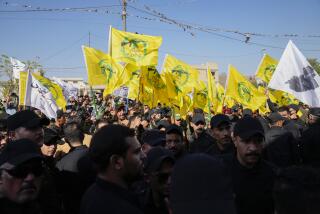Iran Public Reluctant to Back Afghanistan War
- Share via
TEHRAN — Iran capped two weeks of saber-rattling against Afghanistan’s ruling Taliban militia with a display of its military prowess Friday, a three-hour parade of troops and weapons that included the public debut of a new Iranian missile that can strike at enemies 800 miles away.
But chants of “Death to the Taliban!” at Friday prayers and recent bellicose statements by military commanders and hard-liners in the regime notwithstanding, there were signs among the parade’s onlookers that the public mood has swung in the opposite direction.
Almost everyone seemed to cringe at the thought that a new generation of young men could be dragged into an Afghan quagmire, despite widespread revulsion at the killing of eight Iranian diplomats and a journalist by the Taliban fighters.
Iran’s twin moods, preparedness and reluctance, were on display at the annual military parade to mark Sacred Defense Week, a time when Iranians mournfully recall the start of their calamitous eight-year war with Iraq in 1980 and pay homage to the veterans.
“For three years, I was on the front line in the war, and it was very terrible,” said Mahmoud Saharghez, a 32-year-old civil servant who brought his wife and children to watch the parade from the green lawns and fountains of Freedom Square, dominated by a soaring marble monument to the Islamic Revolution.
“Of course, I am not afraid if I have to go again to fight,” Saharghez said. “But I worry about all the women and children who are going to die or lose everything.”
Another veteran, Reza, 36, said he brought his children to the parade to teach them to remember and to show that their country is strong.
“Although I was in the war, it does not mean that we want another war,” he said, dismissing a suggestion that Iran would have to go on the offensive to avenge the slain diplomats.
“We were not led by emotions when we did our [1979] revolution, we were not led by emotions when we entered the war with Iraq, and we will not be led by emotions now,” he said.
“I don’t think anyone wants to go to fight,” agreed one Iranian intellectual, who asked not to be identified by name because he holds a sensitive, quasi-diplomatic position. “What do we have to gain? Is there even a bridge left in Afghanistan that is worth bombing?”
Under blue skies, smart ranks of Iranian soldiers, sailors, air force personnel and members of the Revolutionary Guard goose-stepped their way past a reviewing stand where President Mohammad Khatami looked on somberly.
Thrilling the crowd, parachutists dropped from desert-camouflage military helicopters and floated down in front of Khatami’s platform. Some in the crowd sighed audibly when lines of war-wounded veterans were rolled in wheelchairs or hobbled on crutches past the reviewing stand.
Khatami had returned only two days earlier from the opening of the U.N. General Assembly. In New York, he had sought international cooperation to put pressure on the Taliban, a Sunni Muslim movement that claims it is introducing the purest form of Islam in the world, to cease war crimes and stop reprisals and persecutions of Shiite Muslims.
The Iranian military has been put on highest alert, and officials say that as many as 270,000 Iranian troops are massed along the Afghan border, ready to act if necessary.
“Today, in oppressed Afghanistan, the rule of a reactionary, violent and illogical group is creating grounds for turmoil in the whole region,” Khatami said.
Iran is pursuing a “logical” strategy aimed at isolating the Taliban internationally, he said, and only if that failed would force be considered.
“We do our utmost through diplomatic channels to fight all the elements that cause tension,” the president told the crowd in a brief address at the beginning of the parade. “But our nation, and our armed forces, are always ready to punish these elements if diplomacy fails.”
The country’s supreme leader, Ayatollah Ali Khamenei, commander-in-chief of the armed forces, did not attend the parade.
Last week, at the funeral of six of the nine Iranians killed by the Taliban, chanting members of the Revolutionary Guard urged Khamenei to declare a holy war on the Taliban.
Earlier this month, the Taliban admitted the killings after capturing the northern Afghan city of Mazar-i-Sharif in August. Iran was not mollified when the Taliban leadership blamed the killings on rogue soldiers.
Iran has long complained that the Taliban is committing genocide against the Shiite minority inside Afghanistan and espousing a primitive and brutal form of Islam that brings the faith into worldwide disrepute.
At the parade, Iran showed off a host of weaponry, including tanks, armored personnel carriers and fighting vehicles, surface-to-air missiles and artillery.
Included in the show of might was the Shehab 3 missile, a medium-range weapon that Iran successfully tested in late July.
U.S. military analysts believe that the missile is based on a North Korean design and that its development was aided by Russian technology transfers. Iran, however, says it built the missile on its own.
The missile has a potential range of about 800 miles, meaning it is capable of easily striking targets in Afghanistan, as well as Israel, Turkey, Russia or the entire Arabian peninsula.
Iran, which was the victim of repeated Iraqi missile attacks during the 1980-88 war and sees itself as vulnerable to missile or air attack from Israel and other neighboring countries, says it has no aggressive intentions but rather will rely on the weapon as a deterrent.
More to Read
Sign up for Essential California
The most important California stories and recommendations in your inbox every morning.
You may occasionally receive promotional content from the Los Angeles Times.













